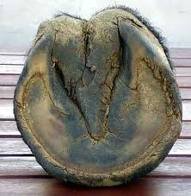If one person is having a problem, chances are there are more people having the same problem. This was the first call of the day for me this morning:
“You changed your size chart for the Glove and the boots that I ordered don’t fit!”
I asked the lady on the phone how long her horse had been barefoot. She said that she started transitioning her horse just over a year ago and that her barefoot trimmer was doing an excellent job with getting his hoof to a natural shape. As she talked, it became evident that her horse had finally got his real hooves.
 A few facts about transitioning a shod horse to a natural barefoot horse
A few facts about transitioning a shod horse to a natural barefoot horse
Hoof growth occurs from the coronary band down toward the toe. The average hoof grows about one quarter inch per month. Since the average hoof is about four inches long, the horse grows a new hoof capsule every year, or more quickly depending on the amount of work.
Hooves that grow fast are considered to be a good quality hoof and much easier to keep trimmed. Factors that affect hoof growth are age, season, injury and nutrition.
Did I say season? Yes, a horse’s hoof grows faster in the spring than during other seasons. It seems that hoof growth rate may be influenced by climate. Hoof growth is slower during the winter months. It seems to me, though, that since hoof growth is affected by exercise and heart rate, it would make sense that most horses are ridden more in the spring than in the winter.
 Did I say heart rate? Yes, I did. Hoof growth seems to be directly correlated to heart rate. Young horses have a higher heart rate than older horses. So, young horses grow their hooves faster than older horses. Hoof growth decreases as a horse gets older. However, a horse that is perpetually in training or that is really conditioned has a lower heart rate that a horse that gets ridden once a week and their hoof growth is faster. So, I just contradicated myself, right? It’s possible that the exercise that they get is offset by the effect of the lower heart rate. But, we can also go back to the fact that hoof growth is stimulated by exercise.
Did I say heart rate? Yes, I did. Hoof growth seems to be directly correlated to heart rate. Young horses have a higher heart rate than older horses. So, young horses grow their hooves faster than older horses. Hoof growth decreases as a horse gets older. However, a horse that is perpetually in training or that is really conditioned has a lower heart rate that a horse that gets ridden once a week and their hoof growth is faster. So, I just contradicated myself, right? It’s possible that the exercise that they get is offset by the effect of the lower heart rate. But, we can also go back to the fact that hoof growth is stimulated by exercise.
All of this comes back to the point that when you transition your horse from shod to barefoot, expecially in the first year, his hoof is probably going to change dramatically. He will probably get away from the cone-shaped hoof and transform into the rounder-shaped hoof of the wild horse.
At EasyCare, we are here to help you with information about the barefoot horse, natural horse care and the sizing and selection of our EasyCare protective horse boots. And we promise to let you know if we make any changes to our size charts.
Dee Hoime

Customer Service
When you call EasyCare, I’m one of the folks that will answer. I’m also one of the cowgirls in the group. (Heck no, I don’t show, I Rodeo!) When it comes to life’s adventures – never pull back on the reins, and remember: the world is best-viewed through the ears of a horse!




